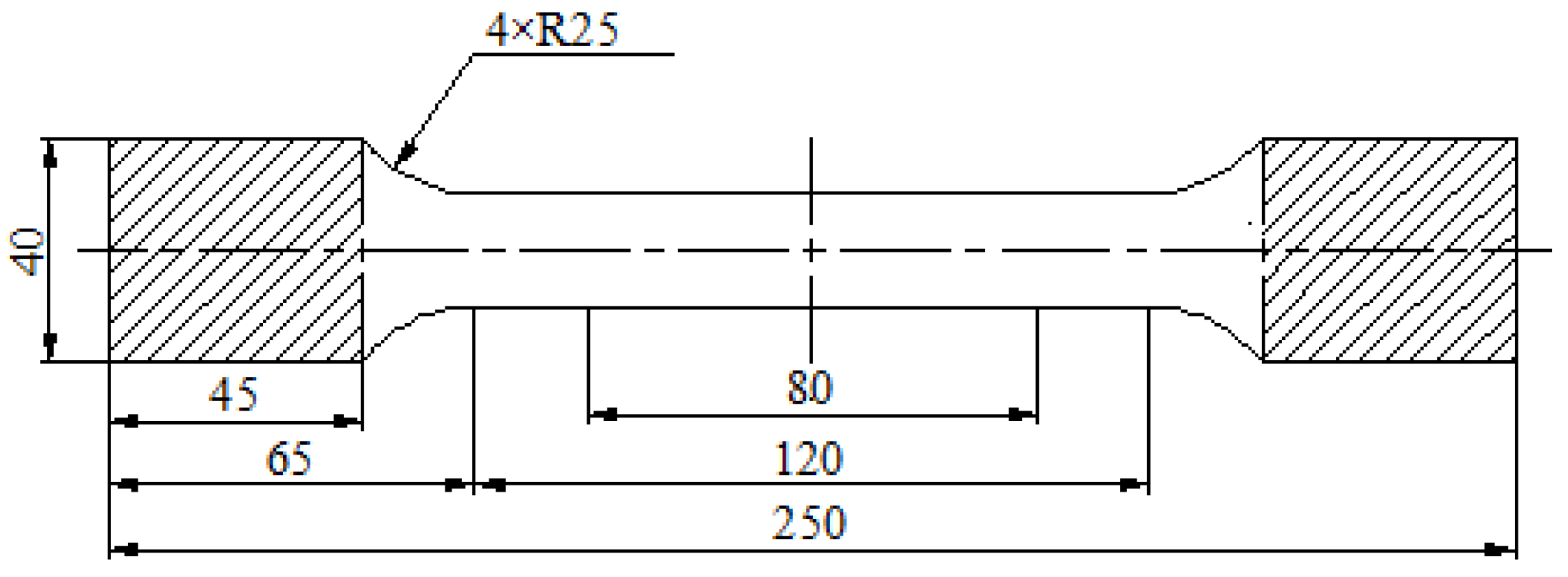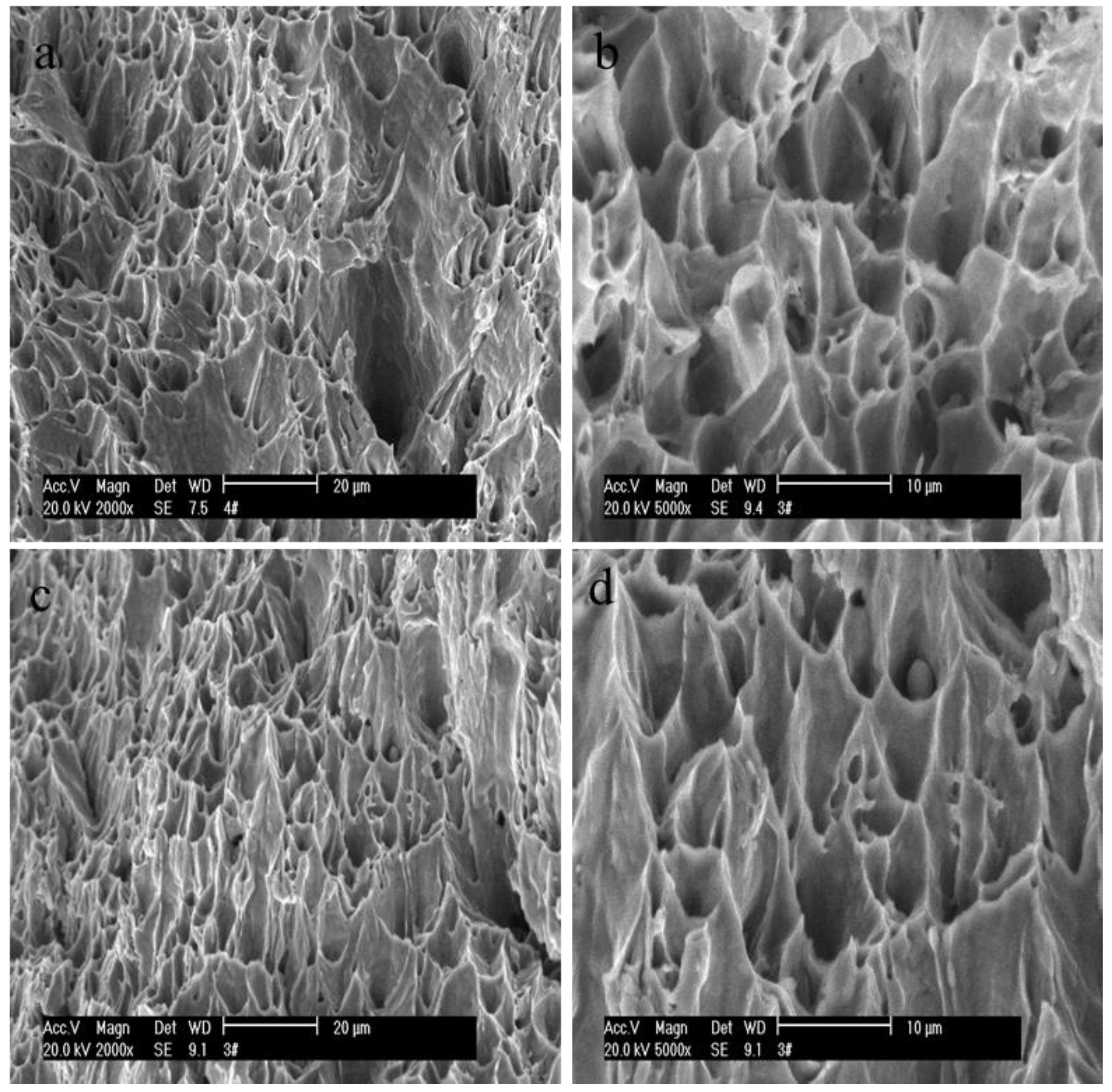Study on the Deformation and Fracture Mechanisms of Plastic Metals Considering Void Damage
Abstract
:1. Introduction
2. Materials and Experiments
3. Characterization of the Stress State
4. Mechanisms of Deformation and Ductile Fracture
4.1. The Mechanism of Void Nucleation
4.2. Ductile Damage Theory
4.3. Constitutive Modeling and Fracture Mechanism
5. Results and Discussion
6. Conclusions
- (1).
- Microscopic observation of the material fracture surfaces with an SEM revealed the presence of numerous dimples. Among them, only one dimple contained an inclusion, which indicated a typical dimple fracture pattern.
- (2).
- Plastic deformation of the metal resulted in an oversaturation of vacancies, leading to the nucleation of voids at vacancy agglomeration sites. After void nucleation, under high stress triaxiality, the voids continued to grow without material flow to compensate for the pore defects, causing adjacent pores to coalesce and form microcracks. Subsequent crack propagation eventually led to the fracture of the plastic metal.
- (3).
- Considering the nucleation, growth, and coalescence effects of voids during the plastic deformation of metals, the damage parameters were derived using the R-T model. By combining them with the continuum damage theory, the plastic potential function, hardening curve, and constitutive model were established. The obtained hardening curve showed a good fit with the experimental data, thus validating the accuracy of the plastic potential function, hardening curve, and constitutive model constructed by considering the volume fraction of voids. This confirmed that they can effectively describe the deformation behavior of the material.
Author Contributions
Funding
Data Availability Statement
Acknowledgments
Conflicts of Interest
References
- Liu, Q.; Wang, J.H.; Zhao, Z.L.; Pu, J.Q.; Yu, D.C.; Luo, S. Study on characteristics of cracking leakage of large oil storage tanks. Contemp. Chem. Ind. 2015, 44, 570–573+576. [Google Scholar]
- Li, R.F.; Lin, J.W.; Yue, B.L.; Zhang, C.Y. Analysis of jar breaking and falling accident in Bohai oilfield. Petrochem. Ind. Technol. 2020, 27, 72–74. [Google Scholar]
- Yang, S.G.; Jin, Z.M.; Gao, H.; Wei, C. Analysis of pipeline fracture accident. Saf. Technol. Spec. Equip. 2021, 4, 18–20. [Google Scholar]
- Mcclintock, F.A. A criterion for ductile fracture by the growth of holes. J. Appl. Mech. 1968, 35, 363–371. [Google Scholar] [CrossRef]
- Argon, A.S.; Im, J.; Safoglu, R. Cavity formation from inclusions in ductile fracture. Met. Trans. A 1975, 6, 825–837. [Google Scholar] [CrossRef]
- Landron, C.; Bouaziz, O.; Maire, E.; Adrien, J. Characterization and modeling of void nucleation by interface decohesion in dual phase steels. Scr. Mater. 2010, 63, 973–976. [Google Scholar] [CrossRef]
- Beremin, F.M. Cavity formation from inclusions in ductile fracture of A508 steel. Met. Mater. Trans. A 1981, 12, 723–731. [Google Scholar] [CrossRef]
- Roy, G.L.; Embury, J.D.; Edwards, G.; Ashby, M.F. A model of ductile fracture based on the nucleation and growth of voids. Acta Met. 1981, 29, 1509–1522. [Google Scholar] [CrossRef]
- Ye, J.H.; Fan, Z.P. Ductile fracture behavior of steel under complex stress state based on microscopic mechanism. Eng. Mech. 2021, 38, 38–49. [Google Scholar] [CrossRef]
- Zhang, J.C.; Lian, C.W.; Han, F. Study on hardening and failure behavior of the 3rd generation ultra-high strength steel QP1180. J. Mech. Eng. 2022, 58, 117–125. [Google Scholar] [CrossRef]
- Gruson, A.L. Continuum theory of ductile rupture by void nucleation and growth: Part I—Yield criteria and flow rules for porous ductile media. J. Eng. Mater. Technol. 1977, 99, 2–15. [Google Scholar] [CrossRef]
- Tvergaard, V.; Needleman, A. Analysis of the cup-cone fracture in a round tensile test bar. Acta Met. 1984, 32, 157–169. [Google Scholar] [CrossRef]
- Needleman, A.; Tvergaard, V. An analysis of ductile rupture in notched bars. J. Mech. Phys. Solids 1984, 32, 461–490. [Google Scholar] [CrossRef]
- Deng, Q.F. Analysis for High Temperature Cracking Behavior of MnS Inclusions Based on GTN Damage Model. Master’s Thesis, Yanshan University, Qinhuangdao, China, 2018. [Google Scholar]
- Jiang, W. Study of Ductile Fracture Based on Meso-Damage Mechanisms. Ph.D. Thesis, Northwestern Polytechnical University, Xi’an, China, 2016. [Google Scholar]
- Dong, J.P.; Wang, S.L.; Zhou, J.; Yang, B.; Ma, C. The ductile fracture criterion of stainless-steel tubes in the shearing process based on modified GTN model. Eng. Mech. 2021, 38, 239–247. [Google Scholar] [CrossRef]
- Maire, E.; Bouaziz, O.; Michiel, M.D.; Verdu, C. Initiation and growth of damage in a dual-phase steel observed by X-ray microtomography. Acta Mater. 2008, 56, 4954–4964. [Google Scholar] [CrossRef]
- Wu, Y.J.; Zhuang, X.C.; Zhao, Z. Fracture topography analysis of C45 steel under different stress state. J. Plast. Eng. 2013, 20, 106–110. [Google Scholar] [CrossRef]
- Yan, H.D.; Jin, H. Three-dimensional characteristics and morphological evolution of micro/meso pores in G20Mn5N steel castings. Acta Met. Sin. 2019, 55, 341–348. [Google Scholar] [CrossRef]
- Huang, X.W.; Zhao, W.; Zhao, J.; Wang, Z. Fracture model of Q235B steel considering the influence of stress triaxiality and lode parameter. J. Basic. Sci. Eng. 2019, 27, 1172–1187. [Google Scholar] [CrossRef]
- Othmen, K.B.; Haddar, N.; Jegat, A.; Manach, P.Y.; Elleuch, K. Ductile fracture of AISI 304L stainless steel sheet in stretching. Int. J. Mech. Sci. 2020, 172, 105404. [Google Scholar] [CrossRef]
- Tang, B.T.; Wu, F.X.; Guo, N.; Liu, J.Y.; Ge, H.L.; Bruschi, S.; Li, X.S. Numerical modeling of ductile fracture of hot stamped 22MnB5 boron steel parts in three-point bending. Int. J. Mech. Sci. 2020, 188, 105951. [Google Scholar] [CrossRef]
- Li, Q.; Zhang, H.M.; Chen, F.; Xu, D.K.; Sui, D.S.; Cui, Z.S. Study on the plastic anisotropy of advanced high strength steel sheet: Experiments and microstructure-based crystal plasticity modeling. Int. J. Mech. Sci. 2020, 176, 105569. [Google Scholar] [CrossRef]
- Barnwal, V.K.; Lee, S.Y.; Choi, J.; Kim, J.H.; Frédéric, B. On the fracture characteristics of advanced high strength steels during hydraulic bulge test. Int. J. Mech. Sci. 2021, 190, 106032. [Google Scholar] [CrossRef]
- Qian, L.Y.; Ji, W.T.; Wang, X.C.; Sun, C.Y.; Ma, T.Y. Research on fracture mechanism and prediction of high-strength steel sheet under different stress states. J. Mech. Eng. 2020, 56, 72–80. [Google Scholar] [CrossRef]
- Marteleur, M.; Leclerc, J.; Colla, M.S.; Nguyen, V.D.; Pardoen, T. Ductile fracture of high strength steels with morphological anisotropy, Part I: Characterization, testing, and void nucleation law. Eng. Fract. Mech. 2021, 244, 107569. [Google Scholar] [CrossRef]
- Ding, H.J.; Zou, B.; Wang, X.F.; Liu, J.K.; Li, L. Microstructure, mechanical properties and machinability of 316L stainless steel fabricated by direct energy deposition. Int. J. Mech. Sci. 2022, 243, 108046. [Google Scholar] [CrossRef]
- Noell, P.J.; Sabisch, J.E.C.; Medlin, D.L.; Boyce, B.L. Nanoscale conditions for ductile void nucleation in copper: Vacancy condensation and the growth-limited microstructural state. Acta Mater. 2020, 184, 211–224. [Google Scholar] [CrossRef]
- Rousselier, G. Finite deformation constitutive relations including ductile fracture damage. In Three Dimensional Constitutive Relations and Ductile Fracture; Nemat-Nasser, S., Ed.; Elsevier: Amsterdam, The Netherlands, 1981; pp. 319–343. [Google Scholar]
- Rousselier, G. Ductile fracture models and their potential in local approach of fracture. Nucl. Eng. Des. 1987, 105, 97–111. [Google Scholar] [CrossRef]
- Rice, J.R.; Tracey, D.M. On the ductile enlargement of voids in triaxial stress fields. J. Mech. Phys. Solids. 1969, 17, 201–217. [Google Scholar] [CrossRef]
- Huang, Y.; Hutchinson, J.W.; Tvergaard, V. Cavitation instabilities in elastic-plastic solids. J. Mech. Phys. Solids. 1991, 39, 223–241. [Google Scholar] [CrossRef]




| Initial Sample Number | Test Number | Mass Fraction w/% | Young’s Modulus E/MPa | Yield Strength /MPa | Ultimate Tensile Strength /MPa | |
|---|---|---|---|---|---|---|
| C | Mn | |||||
| steel No. 1 | KTM 05-1 | 0.09 | 0.36 | 80,552 | 161.10 | 267.21 |
| steel No. 2 | KTM 05-2 | 0.18 | 0.38 | 100,363 | 200.73 | 287.56 |
| Grade | Mass Fraction w/% | Yield Strength /MPa | Ultimate Tensile Strength /MPa | |
|---|---|---|---|---|
| C | Mn | |||
| 08F | 0.05~0.11 | 0.25~0.50 | 175 | 295 |
| 08 | 0.05~0.12 | 0.35~0.65 | 195 | 325 |
| 10F | 0.07~0.14 | 0.25~0.50 | 185 | 315 |
| 10 | 0.07~0.14 | 0.35~0.65 | 205 | 335 |
| 08Al | 0.05~0.12 | 0.25~0.65 | 205 | 375 |
| Grade | Mass Fraction w/% | Yield Strength /MPa | Ultimate Tensile Strength /MPa | |
|---|---|---|---|---|
| C | Mn | |||
| 15F | 0.12~0.19 | 0.25~0.50 | 205 | 355 |
| 15 | 0.12~0.19 | 0.35~0.65 | 225 | 375 |
| 15Al | 0.12~0.19 | 0.35~0.65 | 235 | 415 |
| 20 | 0.17~0.24 | 0.35~0.65 | 245 | 410 |
| Material | The Error between Fitting and Experimental Yield Stress | B/MPa | m | |
|---|---|---|---|---|
| Steel No. 1 | 162.73 | 0.63% | 241.575 | 0.253 |
| Steel No. 2 | 204.94 | 2.1% | 292.266 | 0.397 |
Disclaimer/Publisher’s Note: The statements, opinions and data contained in all publications are solely those of the individual author(s) and contributor(s) and not of MDPI and/or the editor(s). MDPI and/or the editor(s) disclaim responsibility for any injury to people or property resulting from any ideas, methods, instructions or products referred to in the content. |
© 2023 by the authors. Licensee MDPI, Basel, Switzerland. This article is an open access article distributed under the terms and conditions of the Creative Commons Attribution (CC BY) license (https://creativecommons.org/licenses/by/4.0/).
Share and Cite
Zeng, J.; Liu, J.; Jia, Y.; Zhao, G. Study on the Deformation and Fracture Mechanisms of Plastic Metals Considering Void Damage. Metals 2023, 13, 1566. https://doi.org/10.3390/met13091566
Zeng J, Liu J, Jia Y, Zhao G. Study on the Deformation and Fracture Mechanisms of Plastic Metals Considering Void Damage. Metals. 2023; 13(9):1566. https://doi.org/10.3390/met13091566
Chicago/Turabian StyleZeng, Jiaxing, Jianxiong Liu, Youdong Jia, and Guolin Zhao. 2023. "Study on the Deformation and Fracture Mechanisms of Plastic Metals Considering Void Damage" Metals 13, no. 9: 1566. https://doi.org/10.3390/met13091566
APA StyleZeng, J., Liu, J., Jia, Y., & Zhao, G. (2023). Study on the Deformation and Fracture Mechanisms of Plastic Metals Considering Void Damage. Metals, 13(9), 1566. https://doi.org/10.3390/met13091566






